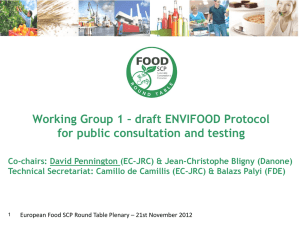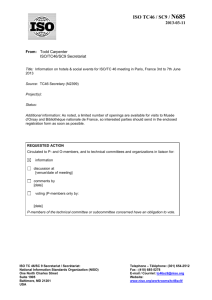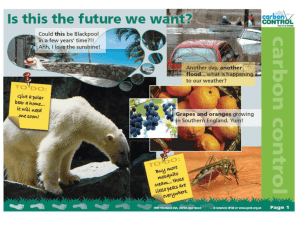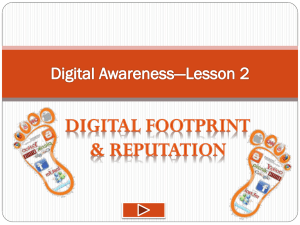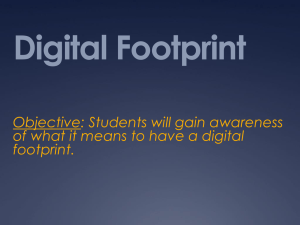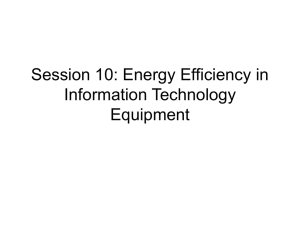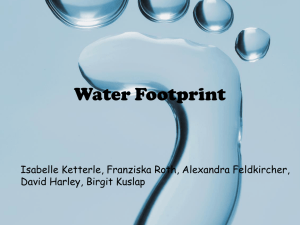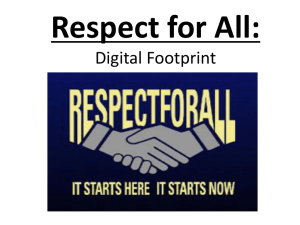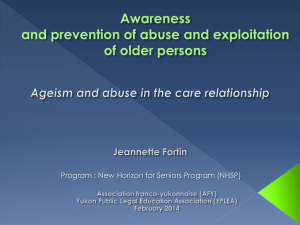National experiment
advertisement
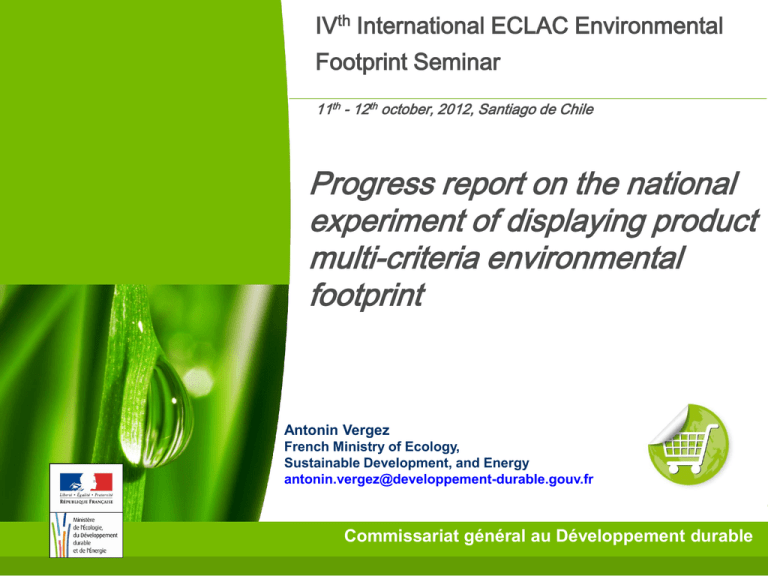
IVth International ECLAC Environmental Footprint Seminar 11th - 12th october, 2012, Santiago de Chile Progress report on the national experiment of displaying product multi-criteria environmental footprint Antonin Vergez French Ministry of Ecology, Sustainable Development, and Energy antonin.vergez@developpement-durable.gouv.fr Commissariat général au Développement durable 1 The french system for displaying products' environmental footprint : 5 pillars 1) Legislative basis : 2 laws “Grenelle” (2009, 2010) 2) Supporting the private initiatives since 2008-2011 3) ADEME AFNOR technical and multi-stakeholders « expertise and standardisation » platform 4) National experiment: July 2011-12 5) Sharing methodological developments at the European level and information at international level 2 Legislative basis : 2 articles in 2 Grenelle laws, in a nutshell Grenelle 1, art. 54: « Consumers must have access to sincere, objective and comprehensive environmental information on [...] product / packaging pair […] France will support […] same requirements on the European Union level. […] The methodology […] will be discussed […] with the relevant stakeholders.” Grenelle 2, art.228: – a one year long experimentation phase … – … starting 1 July 2011… – … LCA approach… – multicriteria (carbon footprint + at least 1 other) – consumer level – after assessment : a potential generalization of the measure 3 ADEME AFNOR technical and multi-stakeholders « expertise and standardisation » platform (1) General platform with industry and stakeholders Methodological working group 670 organisations Sector working groups (product categories) Communication format working group Database governance committee >1000 stakeholders 4 ADEME AFNOR technical and multi-stakeholders « expertise and standardisation » platform (2) BP X 30-323 : Repository of « good practices » General guidelines to develop PCR General methodology for the quantification of environmental impacts LCA, B2C, Product and packaging, Multicriteria Product Category Rules (PCR) : – Finalised & validated : Food, beverage, pet food , Shoes, Backpacks, Shampoos, Toilet paper, TV, Rackets, Bedding, Disposable nappies, Wooden furnitures, Sofa, Sport balls, Disposable nappies, Printer paper – In progress : Detergents, Clothes, Stationery, Toys, Dairy, Fats All documents available in English: http://www.boutique.afnor.org 5 ADEME generic database and ADEME AFNOR platform Platform ADEMEAFNOR - Methodological WG - Sector WG BP X 30 -323 PCRs, Sector Meth. Ref. Doc Sectors Calculation tools ADEME public generic database Governance Steering Committees 6 National experiment : specifications Requirements: – quantification + communication to the end consumer – compliance with BPX 30-323 and PCR (if already adopted) – multicriteria (carbon footprint + at least one more envir. criterion) – To be tested: technical feasibility, communication, costs, methods, data access, etc. Flexibility has been given to the companies: – Communication formats and media – Choice of additional environmental indicators – starting date (between 1 July until 1 December 2011) 7 National experiment: diversity of selected companies 230 applicants 168 selected companies – from all sectors – 70 from the food sector – Size : • 30% have less than 50 employees • 25% have more than 500 employees – Foreign companies : • Agricom (Chile), Bogota Chamber of Commerce (Colombia), H&M (Sweden) • French branches of multinationals: – Nestlé, Coca-Cola, Pepsico, ColgatePalmolive, Heineken, Levi Strauss, Procter and Gamble, Unilever, J&J, Henkel etc. size 8 National experiment: a wide range of sector and products • Food…………………………………….. • Beverage……………………………….. • Body care………………………………. • Clothing, shoes, home textiles……….. • Stationery, publication, edition……….. • Electric & electronic equipt, furniture… • Building materials………………………. • Supermarkets distribution……………… • Others……………………………………. 9 National experiment: some examples 10 Paintings 11 Shampoos 12 Printed paper 13 Organic oat 14 Trout 15 Coffee Smart phone : proxy produit Magazine (« Croquons la vie ») Web 16 Wine On product + web 17 Grappe juice On the back of the pack : • definitions, • weblink www.indice-environnemental.fr) for more informations • code 2D : access to the information details Environmental Index is located front of the pack 18 Jeans Panels in the stores 19 Assessing the national experiment: main tools Official questionnaire to all participating pioneering companies Self-assessment by the companies ~ 30 bilateral interviews by E&Y operating on behalf of the Ministry Assessment by 7 consumers organisations Tests of « controlability » by the French market surveillance authorities (DGCCRF) : 21 participating companies Spontaneous contributions by sectors, sub-sectors, other companies ► General assessment and synthesis by the ministry, transmitted to the Parliament : end of 2012, beginning of 2013 20 Assessing the national experiment: official questionnaire from the Ministry Global assessment by the company of its participation to the French experiment Adaptations in relation to the initial commitments in the application Perceptions of data availability and of calculation methods Collection and traceability of information and data Choice of formats and media for the communication part Resources involved by the company (time, HR, money) « To go further: your ideas are welcome ! » http://www.developpement-durable.gouv.fr/IMG/pdf/Questionnaire.pdf 21 Assessing the national experiment: main items – Technical feasability and data issues – Communication format & media – Relations along the supply chains – Costs (in experimental conditions) – Other business effects (internal mobilization) – Consumer reaction and understanding : no immediate effect on consumer behaviour was expected – How to guarantee reliability of the information 22 Assessing the national experiment: what we have learned so far It is feasible, it is feasible for SMEs Business mobilisation and involvment : success of the call Boosting expertise, collective capacity building, business creativity Ii induced internal, sector and supply-chain (eg. retailer-producer, producer-supplier) cooperations Advantages of being pioneers : improvement of corporate image Few remaining technical issues International interest (institutional and private), a laboratory for Europe Need for methodological harmonization in order to have comparability, access to public data and simple calculating tools 23 Schedule 2/ Projects completion 5/ Report to the Parliament 3/ Experiment 1/ Selection among the applicants 01/2011 4a/ Intermediate appraisals, discussions and contributions, final assessment 07/2011 07/2012 2011 2012 10/2011 2013 01/201 3 4b/ Survey of food projects 24 Considering already adopted specific measures CO2 information on transport services: obligatory from 2013 VOC label on construction, decoration and elec. products: obligatory for new products in 2012, all products from Sept. 2013 Preparation of a measure establishing an official framework for EPDs on construction and decoration products Experience of the nutritional labelling in the food sector 25 Please visit http://www.developpement-durable.gouv.fr/experimentation-affichage http://www.developpement-durable.gouv.fr/Product-EnvironmentalFootprint.html 26 Thank you for your attention ! Contact: Antonin Vergez tel: +33 1 40 81 85 31 antonin.vergez@developpement-durable.gouv.fr 27
